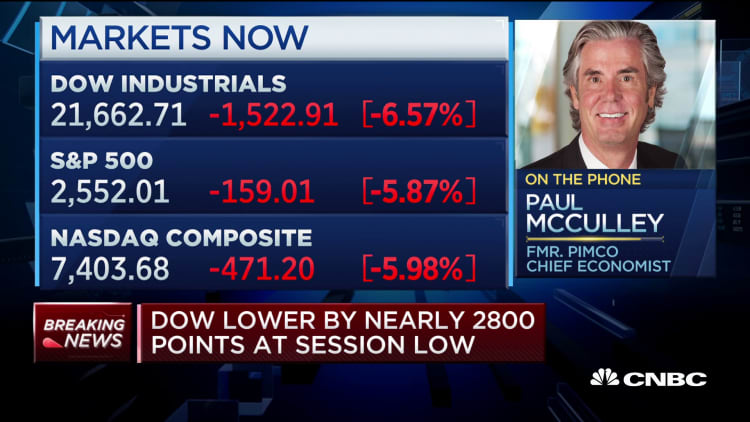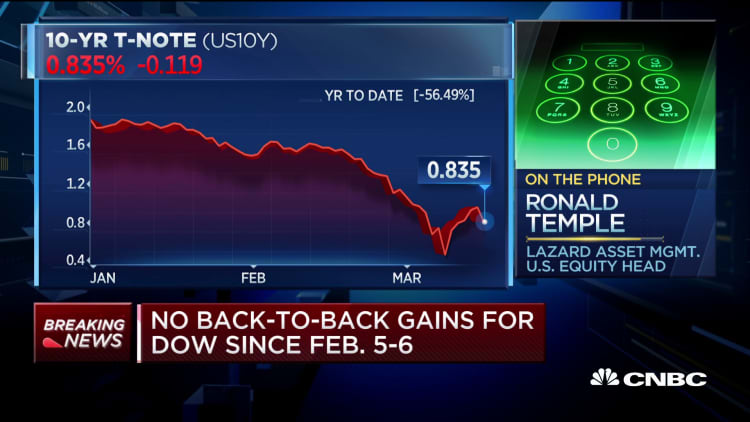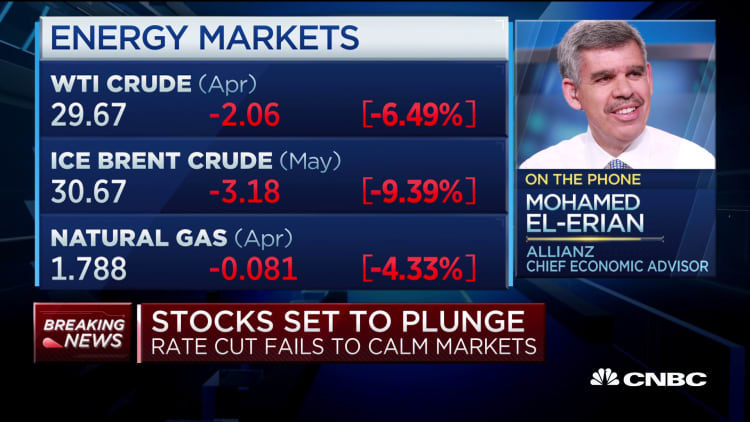Extraordinary Federal Reserve actions over the weekend were unable to avert yet another market bloodbath Monday and may yet prove insufficient to address the economic carnage from the coronavirus crisis.
That doesn't mean, though, that central bank officials won't try, as they still have weapons at their disposal to at least play a secondary role in a recovery.
The 1 percentage point rate reduction and institution of $700 billion in asset purchases — quantitative easing — announced Sunday represented two of the Fed's more obvious policy choices. Now, a slew of other options await, ranging all the way up to seeking emergency powers and even rewriting their charter.
"The Fed's actions should help to stem some of the panic in markets, but it is just the start," Michelle Meyer, U.S. economist at Bank of America Global Research, said in a note for clients. "We think the proper policy response will require coordinated and forceful action from both the fiscal and monetary front."

Meyer was one of many Fed-watchers who characterized as powerful the arsenal it unloaded against what looks like a recession already in progress or not far in the future. The Fed sought both to pull down borrowing costs and to set up liquidity measures for the Treasury market and financial system.
"This is much more like 'QE infinity' — the Fed will do whatever it takes to make sure there is more normal functioning of the Treasury market," Meyer wrote.
Even with the aggressive easing measures and the massive interest rate cuts, markets were left wanting for more.
'Well beyond' what the Fed can do
Monday's trading saw more huge losses for the major index, and observations from Wall Street pros took a familiar theme: Monetary policy alone won't rescue the economy from the coronavirus abyss.
"Given the circumstances, I think they did what was within their power to do," Eric Winograd, U.S. economist at Alliance Bernstein, said in an interview. "I don't think the market reaction reflects any particular disappointment with what the Fed did. What is necessary goes well beyond what monetary policy can accomplish."
Fed officials received some advice from a former central banker — one-time Governor Kevin Warsh penned an op-ed for the Wall Street Journal in which he encouraged delving into the financial crisis playbook. Specifically, he cited the Section 13(3) powers of the Federal Reserve Act to establish a Government-Backed Credit Facility to "ensure that sound businesses and households have ready access to cash to get through the crisis."
Warsh's commentary drew plenty of attention on the Street, but most economists, fixed income experts and market strategists said there are places the Fed can go first before extending itself that far.
Commercial paper, other bonds
For one, many watchers were disappointed there was no mention Sunday of the commercial paper market, where businesses go for unsecured short-term funding. Reports have circulated of a dearth of buyers for the paper companies were sending to market, and the Street was looking for some Fed intervention.
"There's still more they can do and probably will do at some stage of the game," said Kathy Jones, chief fixed income strategist at Charles Schwab. "They certainly pulled out the big guns and did a lot to preserve the markets and to address concerns about liquidity in the markets."
In the days ahead, Jones expects the Fed to institute some type of facility to address commercial paper. In addition, she thinks the central bank will need to address issues in the corporate and municipal bond markets.
"They may indeed need to amend their charter," Jones said, as the Fed act as it is written does not allow for the purchase of corporate bonds. Others even have suggested the Fed buy stocks, likely through exchange-traded funds, though that, too, would require an act of Congress.

In the meantime, the Fed simply could choose to accelerate or even increase the total amount of bonds it is purchasing. The Sunday announcement indicated that the Fed would be buying $500 billion in Treasurys and $200 billion in mortgage-backed securities, though Chairman Jerome Powell said the central bank will do whatever is needed.
"We suspect the Fed next move would be to scale up its Treasury purchases and use more aggressive forward guidance. But with the 10-year yield at just under 70bp, there are clear limits to how much that would achieve," Michael Pearce, U.S. economist at Capital Economics, said in a note. "Instead, the focus in the coming weeks is now squarely on Congress to provide the immediate stimulus the economy needs."
No bottom in sight
Markets have been demanding some type of fiscal stimulus and thus far have seen only talk a few small measures. With many states now essentially in lockdown, the markets and economy both need to know there will be some type of backstop not just through liquidity and the cost of capital, but also through more direct assistance programs.
"They've thrown the ball back to fiscal policy, and what they've done so far is pre-emptive to get ahead of any financial stress," said Scott Clemons, chief investment strategist at Brown Brothers Harriman. "We've certainly seen some liquidity issues in Treasurys. Trading desks have gone remote, spreads have widened out."
Market losses accelerated Monday into the afternoon and bond yields continued to tumble.
Clemons said he doesn't see signs of a market bottom forming but he does see consistency with the crisis markets of 2008 and 2009 "where prices were not only divorced from reality but reality was divorced from reality."
"I think we're in this for some time to come. The news flow is likely to get worse before it gets better," he said. "Until then, I don't know what the bottom is."



